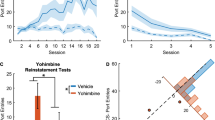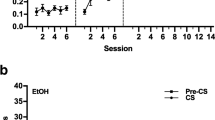Abstract
Rats were tested on a two-way avoidance acquisition with or without inescapable shock given 24 h prior to training. Mescaline given to nonshock rats disrupted acquisition in a dose-dependent fashion and tolerance developed to this disruption. Mescaline given to shock rats had no effect on acquisition even though levels of acquisition were the same for both shock and nonshock rats without drug. Moreover, subchronic treatment (5 days facilitated acquisition. These experiments demonstrate an interaction between shock, which presumably is a stressor, and mescaline. The data are consistent with the observation that when animals are exposed to presumptive stressors (e.g., shock, handling) hallocinogens can facilitate behavior, while in other situations, hallucinogens disrupt behavior.
Similar content being viewed by others
References
Bignami G (1972) Facilitation of avoidance acquisition by LSD-25. Psychopharmacologia 25:146–151
BignamiG, RobustelliF, JankulI, Dovet D (1965) Action de l'amphetamine et de quelques agents psychotropes sur l'acquisition d'un conditionnement de fuite et d'evitement chez des rats selectionnes en fonction du nivaeu particulierement bas de leurs performances. C R Acad Sci (D) (Paris) 260:4273–4278
Bridger WH (1969) The interaction of stress and hallucinogenic drug action: Implications for a pathophysiological mechanism in schizophrenia. In: Siva Sankar DV (ed) Schizophrenia: current concepts and research. PJO Publications, New York, pp 470–476
Bridger WH, Barr GA, Gibbons JL, Gorelick DA (1978) Dual effects of LSD, mescaline and DMT. In: Stillman R, Willette R (eds). Pergamon Press, New York, pp 150–180
Bridger WH, Mandel IJ (1971) Excitatory and inhibitory effects of mescaline on shuttle avoidance in the rat. Biol Psychiatry 3:379–385
Bridger WH, Mandel IJ, Stoff DM (1973) Mescaline: No tolerance to excitatory effects. Biol Psychiatry 7:129–138
Freedman DX, Appel JB, Harman FR, Mollivar ME (1964) Tolerance to behavioral effects of LSD-25 in rat. J Pharmacol Exp Ther 143:309–313
Freedman DX, Gottlieb R, Lovell RA (1970) Psychotomimetic drugs and brain 5-hydroxytryptamine metabolism. Biochem Pharmacol 19:1181–1188
Gessner PK, Page JH (1962) Behavioral effects of 5-methoxy-N:N-dimethyltryptamine, other tryptamine, and LSD. Am J Physiol 203:167–172
Geyer MA, Light RK (1979) LSD-induced alterations of investigatory responding in rats. Psychopharmacology 65:41–47
Gorelick DA, Bozewicz T (1975) Mescaline and shuttlebox escapeavoidance acquisition in rats: Role of task and strain variables. J Pharmacol 6:131–142
Gorelick DA, Bridger WH (1975) Does increasing stress change the behavioral action of mescaline from disruption to facilitation? Psychopharmacologia 44:307–309
Gorelick DA, Bridger WH (1977) Facilitation and disruption by mescaline and 3,4-dimethoxyphenylethylamine of shock avoidance in rats. Psychopharmacology 52:157–163
Leonard BE, Stonier PD (1972) Some neurochemical and neuropharmacological studies on the interactions between mescaline and 1-methyl-1,2,5,6-tetrahydropyridine-3-(N,N-diethylcarboxamide) (THPC). Psychopharmacologia 25:1–13
Smythies JR, Sykes EA, Lord CP (1966) Structure-activity relationship studies of mescaline. II. Tolerance and cross-tolerance between mescaline and its analogues in the rat. Psychopharmacologia 9:434–446
Stoff DM (1973) Multitrial passive avoidance in rats: Mescaline, shock, and ITI effects. Diss Abstr Int B 34:2348
Stoff DM, Mandel IJ, Gorelick DA, Bridger WH (1974) Acute and chronic effects of LSD and 3,4-dimethoxyphenylethylamine on shuttlebox escape-avoidance in rats. Psychopharmacologia 36:301–312
Stoff DM, Gorelick DA, Bozewicz T, Bridger WH, Gillin JC, Wyatt RJ (1978) The indole hallucinogens, N,N-dimethyltryptamine (DMT) and 5-methoxy-N,N-dimethyltryptamine (5-MeO-DMT) have different effects than mescaline on rat shuttlebox avoidance. Neuropharmacology 17:1035–1040
Stolk JM, Barchas JD, Goldstein M, Boggan W, Freedman DX (1974) A comparison of psychotomimetic drug effects on rat brain norepinephrine metabolism. J Pharmacol Exp Ther 189:42–50
Thierry AM, Tassin JP, Blanc G, Glowinski J (1976) Selective activation of the mesocortical dopaminergic system by stress. Nature 263:242–244
Wray SR (1972) A correlative evaluation of cyclazocine, LSD, and naloxone on continuous discriminated avoidance in rats. Psychopharmacologia 26:29–43
Wray SR (1973) Interaction of stress and psychophotomimetic drug-action: Possible implication for psychosis. Psychopharmacologia 30:263–268
Author information
Authors and Affiliations
Rights and permissions
About this article
Cite this article
Gibbons, J.L., Barr, G.A., Schimmel, G.T. et al. Inescapable shock alters mescaline's disruption of active avoidance acquisition. Psychopharmacology 74, 336–338 (1981). https://doi.org/10.1007/BF00432742
Received:
Accepted:
Issue Date:
DOI: https://doi.org/10.1007/BF00432742




